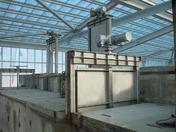Sluice gates
Sluice gates are special structures designed to adjust the working flow, as well as for complete or partial cutting-off of fluid flow. They are applied at pumping stations of treatment and sewerage plants, as well as in the field of water supply and other process flows.
Sluice gates are usually installed on non-pressure troughs supplying the treated liquid to the plants, as well as for discharging water from the openings and chambers of the plant. The necessity of using slice gates during the construction and operation of treatment plants is caused by the requirements for the distribution of wastewater flow between several plants or parts of plants (for example, aerotanks). In addition, the gates are used to completely shut off the flows when it is necessary to carry out repairs of the relevant equipment. The variety of existing trough structures, their sizes, flow control methods, the expense of the overlapped liquid flow, the ways of shutting off the flows causes a wide variety of types and designs of shield gates.
Requirements for the sluice gates
- failure-free operation, preventing skewing and jamming of the gate;
- water-proof surfaces adjacent to the walls of the plant;
- no great efforts needed to move the gate;
- resistance to corrosive fluids of waste liquids, ensuring long-term service life;
- simple design with a minimum of parts required for installation and repair;
- relatively low metal capacity, sufficient to ensure reliability.
My Project sluice gates meet all the above requirements.
The sluice gates are divided into two large groups:
- Emergency sluice gates operate in the Open/Close mode. That is, 100% of the channel or pipeline section is free or blocked.
- Process gates have the function of blocking only a part of the channel or pipeline to allow a specified flow rate of water. Process pipelines also include regulating pipelines with a spillway in the upper part, in which water flow takes place through the spillway of the sluice gate.
The gates can be installed by concreting, flanking or welding.
Main types of the sluice gates
- lay-on sluice gates, mounted on flanges or by welding;
- flumed sluice gates with sealed wall-adjacent sides;
- deep sluice gates with an elongated frame, designed to block flows located substantially below the mark of the serviced site;
- with adjustable spillway for adjusting the flow rate of the waste liquid. The compaction between the movable and fixed panels is due to the dynamic pressure of the flow of the waste liquid;
- non-sealed control gates. The compaction between the gate and the frame racks is due to the dynamic pressure of the flow of the waste liquid;
- any other type of sluice gates, with manual or electric drive, manufactured serially, or on request.
Advantages
- made of stainless steel;
- high reliability, stability and durability;
- high maintainability due to the simplicity of the design;
- different types of drives;
- in the case of a sluice gate with an electric drive, the automated process control is possible.


